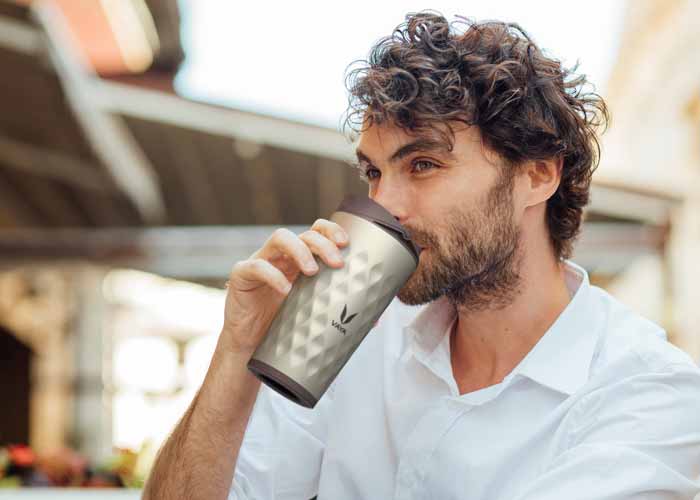Is it safe to drink hot drinks in stainless steel?

Is stainless steel safe for hot drinks
When you buy an 18/8 food-grade stainless steel water bottle, you can be confident that it won't leach chemicals into your water, even if the bottle becomes scratched, dented, or aged. It's also safe to use with hot liquids and, because no liner is needed, it won't hold bad tastes.
Can you put hot tea in a stainless steel water bottle
Even though a single wall of stainless steel bottle can easily hold the temperature of your beverages for a few hours. However, if you want to keep your beverages hot for longer, you can use a double-walled stainless-steel bottle. For example, a WIDE MOUTH TWO-TONE bottle can easily keep your beverages hot for hours.
Can you put hot liquids in a stainless steel tumbler
Stainless steel tumblers are perfect for both hot and cold drinks.
What should you not drink with stainless steel
One study on stainless steel water bottles found that:
Leaching of nickel occurred in curd, fruit juice andpickle (more acid) Leaching of chromium occurred in milk, coffee, and tea (only slightly acid)
Is stainless steel safe to drink coffee from
Stainless steel does not contain harmful substances that can negatively impact your health, such as BPA, zinc, lead or phthalates, and does not require any coatings. So yes, drinking coffee out of a stainless steel mug or bottle is safe for your health.
Is stainless steel good for drinking coffee
Stainless steel doesn't absorb flavors, but it sometimes imparts off flavors into coffee. Whether this happens because of poor construction (e.g. finishes that leech into beverages) or is due to a reaction between one of coffee's 1,000-plus compounds and the metal isn't always clear. It also doesn't always happen.
Is stainless steel safe for tea
Stainless steel is another of the safest materials for non-toxic kettles that won't leach heavy metals into the water. Make sure you buy a kettle made from high-quality, food-grade stainless steel with a chromium-to-nickel ratio of 18/8 (304) or 18/10 (316).
Is stainless steel bottle safe for drinking water
Stainless Steel Water Bottles are Safe
The plastics in recyclable plastic water bottles are thought to be a health risk. Harmful chemicals are emitted from these bottles, and these chemicals might cause cancer. By switching to stainless steel, you can prevent harmful carcinogens from leaching into your drinking water.
Is coffee OK in stainless steel
He adds: “The acidity in coffee can cause stainless steel to break down over time and release microscopic particles of potentially toxic substances, such as nickel.” While this isn't likely to cause a major health issue for most people, Silvio still recommends that people only use stainless steel cups and bottles for …
Does heat damage stainless steel
When stainless steel is heated, it begins to lose its strength due to a process called austenitization. As the temperature rises, chromium atoms diffuse out of their original place in the alloy and move around within it, making the structure less organized and thus compromising its strength.
Can stainless steel be unhealthy
Stainless steel: Another generally safe option. But experts note that you should ideally refrain from cooking acidic foods, like tomato sauce, in these types of pans. “Stainless steel may have some heavy metals in it, such as nickel and chromium, that can leach, especially when cooking acidic foods,” Minich explains.
Is it better to drink out of stainless steel
Stainless Steel Water Bottles are Safe
The plastics in recyclable plastic water bottles are thought to be a health risk. Harmful chemicals are emitted from these bottles, and these chemicals might cause cancer. By switching to stainless steel, you can prevent harmful carcinogens from leaching into your drinking water.
Is stainless steel good for hot food
In general food grade, stainless steel is safe to use till temperatures between 800 and 900C, while its melting point is more than 1300C. This makes it safe for most of the common kitchen applications and it applies to commonly used food grades of stainless steel such as 304 and 316.
Can you use stainless steel for tea
Unlike clay teapots that are wildly popular in China, stainless steel doesn't absorb or alter the flavor of teas. That means you can use these teapots to brew multiple types of tea without worrying about changing the flavor characteristics of each brew.
Is stainless steel healthy to drink out of
There are no known safety concerns associated with using stainless steel, assuming it is indeed stainless and lead-free.. Compared to water in glass bottles, some people think stainless steel bottles make your water have a metallic taste and some can heat up in summer temperatures.
Is it better to drink water out of glass or stainless steel
TL;DR: Glass is a no brainer—it tastes better by a mile, it won't drop once and dent or scratch to the point of ugly, it's far nicer to the environment than any metal bottle, it's dishwasher safe, and it won't leach toxic chemicals or heavy metals into your water.
What is stainless steel not good for
Some Disadvantages of Stainless Steel
While its high melting point can be a great advantage in some ways, this quality of stainless steel also makes difficult to use in welding, and consequently, the material has limits in how it can be used in construction. Stainless steel is also not the most cost-efficient metal.
Does stainless steel affect tea
The metal can sometimes impart undesirable flavors into your tea, usually if it has developed a patina, trapped water, or has rusted. From iron teapots (unglazed) to stainless steel thermoses, we've tasted some pretty bad tea poured from these things.
What happens if stainless steel gets too hot
Science Behind Heat-Weakened Steel
Stainless steel is an alloy made up mostly of iron, along with chromium and other metals. When stainless steel is heated, it begins to lose its strength due to a process called austenitization.
How hot is too hot for stainless steel
Due to its chromium and nickel content, grade 330 stainless steel can confidently endure temperatures up to 2,000 degrees Fahrenheit. However, for the greatest lifespan, it's recommended only to expose grade 330 alloys to a maximum heat of 1,900 degrees Fahrenheit.



0 Comments